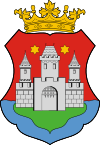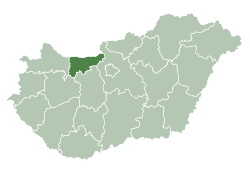Komárom
| Komárom | ||
|---|---|---|
 | ||
| ||
 Komárom Location of Komárom in Hungary | ||
| Coordinates: 47°44′09″N 18°09′11″E / 47.73576°N 18.15296°E | ||
| Country | Hungary | |
| Region | Central Transdanubia | |
| County | Komárom-Esztergom | |
| Subregion | Komáromi | |
| Rank | City | |
| KSH code | 05449[1] | |
| Area[2] | ||
| • Total | 70.19 km2 (27.10 sq mi) | |
| Population (2009)[3] | ||
| • Total | 19,747 | |
| • Density | 280/km2 (730/sq mi) | |
| Time zone | CET (UTC+1) | |
| • Summer (DST) | CEST (UTC+2) | |
| Postal code | 2900 | |
| Area code | +36 34 | |
Komárom (Slovak: Komárno, German: Komorn) is a city split between Hungary on the south bank of the Danube in Komárom-Esztergom county and Slovakia on the other.[4]
The town was heavily damaged in the 1763 Komárom earthquake.
The city of Komárom was formerly a separate suburban village called Újszőny. In 1892 Komárom and Újszőny were connected with an iron bridge and in 1896 the two towns were united under the name Komárom.
The center was split by the newly created border of Czechoslovakia in 1920 following the Treaty of Trianon in which Hungary lost 2⁄3 of its territory creating a sizable Hungarian minority in Slovakia. The Czechoslovak (Slovak) part is now Komárno, Slovakia.
Komárom and Komárno are connected by two bridges: The iron bridge and a newer lifting bridge. A third bridge is planned, with the vast majority of funding coming from the EU's Connecting Europe Facility.[5]
The two towns used to be a border crossing between Czechoslovakia (later Slovakia) and Hungary, until both countries became part of the Schengen Area, resulting in all immigration and customs checks being lifted on December 12, 2007.
Notable people
- Leopold, Cardinal Kollonitsch, born at Komárom in 1631
- Franz Heckenast (1889–1939)
- Franz Lehár (1870-1948)
- Theodor Körner, Austrian President
- Hans Selye
- Tamás Török Hungarian-Slovak freedom fighter
- Endre Komaromi-katz Painter [6]
International relations
Twin towns — Sister cities
Komárom is twinned with:
See also
Notes and references
- ↑ Komárom at the Hungarian Central Statistical Office (Hungarian).
- ↑ Komárom at the Hungarian Central Statistical Office (Hungarian).
- ↑ Komárom at the Hungarian Central Statistical Office (Hungarian). 2009
- ↑ The fortress played an important role in the Hungarian Revolution of 1848 and
many contemporary English sources refer to it as the Fortress of Comorn (e.g. Ripley, George; Anderson, Charles (1860). Google Books: The New American Cyclopaedia Check
|url=value (help). D. Appleton. p. 362.) - ↑ http://www.worldhighways.com/sections/general/news/new-danube-river-bridge-to-get-100-million-finance-from-eu/
- ↑ http://artportal.hu/lexikon/muveszek/komaromi-katz-endre-5176
External links
- Official site
- Aerial photography: Komárom
- Komárom on wiki.utikonyvem.hu
- "The Battle at Comorn in Hungary on 11th July 1849" - painting by Albrecht Adam, 1855
| Wikimedia Commons has media related to Komárom. |

